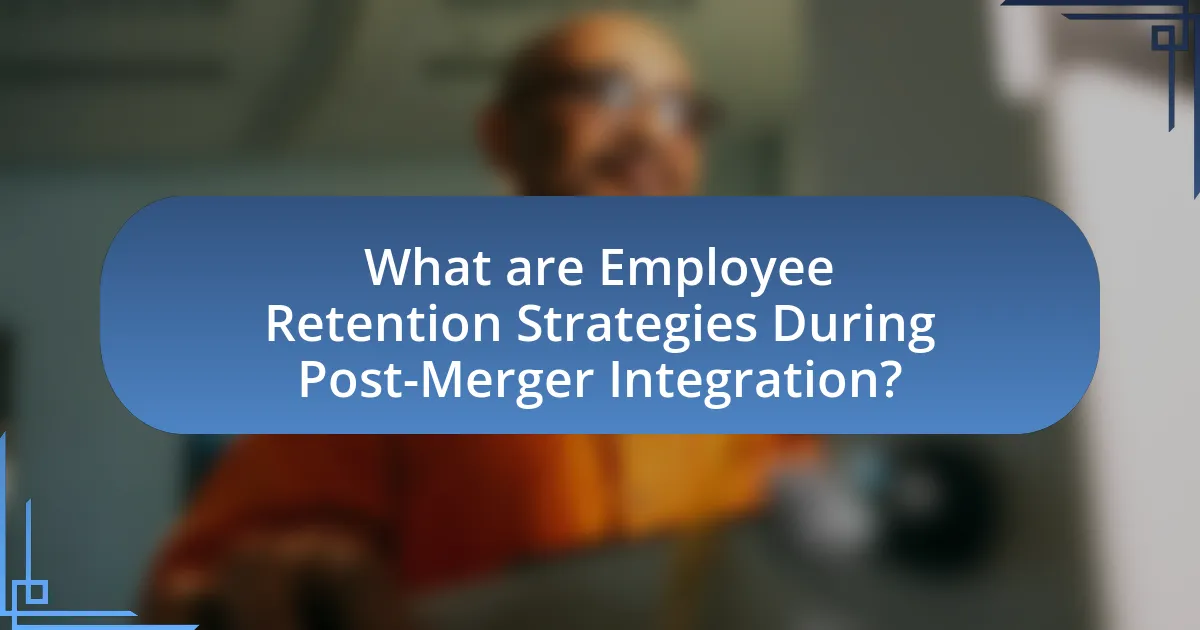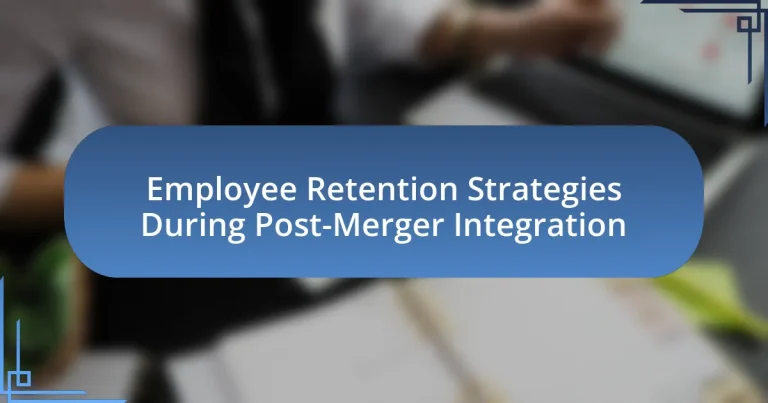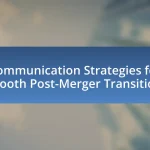Employee retention strategies during post-merger integration are essential for maintaining workforce stability and ensuring the success of the merger. Key strategies include clear communication to alleviate employee uncertainty, cultural alignment to address differing organizational values, and employee engagement initiatives to foster a sense of belonging. Retaining employees is critical as it preserves institutional knowledge and morale, while challenges such as job security anxiety and cultural integration issues can hinder retention efforts. Effective practices, including competitive compensation, career development opportunities, and strong leadership engagement, can significantly enhance retention rates during this transitional phase. Organizations that prioritize these strategies are more likely to achieve their integration goals and maintain a committed workforce.

What are Employee Retention Strategies During Post-Merger Integration?
Employee retention strategies during post-merger integration include clear communication, cultural alignment, and employee engagement initiatives. Clear communication helps to alleviate uncertainty among employees, fostering trust and transparency about the merger’s impact on their roles. Cultural alignment is crucial, as merging organizations often have different values and practices; addressing these differences can enhance employee satisfaction and retention. Employee engagement initiatives, such as feedback mechanisms and recognition programs, can further motivate staff and create a sense of belonging, which is vital during transitional periods. Research indicates that companies with effective communication and engagement strategies experience up to 30% higher retention rates during mergers.
Why is employee retention critical during post-merger integration?
Employee retention is critical during post-merger integration because it ensures continuity, preserves institutional knowledge, and maintains employee morale. High turnover rates can disrupt operations and lead to a loss of valuable skills and expertise that are essential for the successful integration of the merging organizations. According to a study by PwC, 50% of employees in mergers and acquisitions feel uncertain about their future, which can lead to disengagement and increased attrition. Retaining key talent during this transitional phase is vital for achieving strategic objectives and fostering a cohesive corporate culture.
What challenges do organizations face in retaining employees after a merger?
Organizations face several challenges in retaining employees after a merger, primarily due to uncertainty and cultural integration issues. Employees often experience anxiety regarding job security, leading to decreased morale and productivity. Additionally, differing corporate cultures can create friction, making it difficult for employees to adapt to new organizational norms. A study by Towers Watson found that 50% of employees felt uncertain about their roles post-merger, which directly impacts retention rates. Furthermore, lack of clear communication from leadership can exacerbate feelings of insecurity, resulting in higher turnover intentions. These factors collectively hinder organizations’ efforts to maintain a stable workforce during the transition period following a merger.
How does employee retention impact overall merger success?
Employee retention significantly impacts overall merger success by ensuring continuity, maintaining productivity, and preserving organizational knowledge. High employee turnover during a merger can lead to disruptions in operations, loss of critical skills, and decreased morale among remaining staff. Research indicates that companies with effective employee retention strategies during mergers experience a 20% higher success rate in achieving their integration goals. For instance, a study by the Harvard Business Review found that organizations that prioritized employee engagement during mergers were 30% more likely to meet their financial targets post-merger. Thus, retaining employees is crucial for a smooth transition and long-term success in mergers.
What are the key components of effective employee retention strategies?
Effective employee retention strategies include competitive compensation, career development opportunities, a positive workplace culture, and strong communication. Competitive compensation ensures employees feel valued and fairly rewarded for their contributions, which is supported by studies indicating that salary satisfaction directly correlates with employee retention rates. Career development opportunities, such as training and advancement pathways, foster employee engagement and loyalty, as evidenced by research from LinkedIn showing that 94% of employees would stay longer at a company that invests in their career development. A positive workplace culture promotes job satisfaction and reduces turnover, with Gallup reporting that organizations with high employee engagement experience 59% less turnover. Finally, strong communication fosters trust and transparency, which are critical during transitions like mergers; research from McKinsey highlights that effective communication can significantly enhance employee retention during such periods.
How can communication enhance employee retention during integration?
Effective communication enhances employee retention during integration by fostering transparency, building trust, and reducing uncertainty. When organizations clearly communicate their vision, goals, and changes during the integration process, employees feel more informed and engaged. Research indicates that companies with strong communication practices experience 47% higher employee retention rates. Furthermore, open lines of communication allow employees to voice concerns and provide feedback, which can lead to improved morale and a sense of belonging. This engagement is crucial, as studies show that employees who feel valued and heard are 4.6 times more likely to perform at their best, directly impacting retention during transitional periods.
What role does company culture play in employee retention post-merger?
Company culture significantly influences employee retention post-merger by shaping the work environment and employee engagement levels. A strong, cohesive culture can ease the transition for employees, fostering a sense of belonging and loyalty, which is crucial during the uncertainties of a merger. Research indicates that organizations with aligned cultures experience up to 30% higher retention rates compared to those with cultural misalignments. For instance, a study by Deloitte found that 88% of executives believe that a strong culture is essential for successful mergers and acquisitions, highlighting the importance of cultural integration in retaining talent.
What best practices can organizations implement for employee retention?
Organizations can implement several best practices for employee retention, particularly during post-merger integration. Effective communication is crucial; organizations should ensure transparent and consistent messaging about changes and expectations, which helps alleviate uncertainty among employees. Additionally, offering competitive compensation and benefits packages can significantly enhance employee satisfaction and loyalty.
Fostering a positive workplace culture that emphasizes inclusion and recognition is also vital; studies show that organizations with strong cultures experience lower turnover rates. Providing opportunities for professional development and career advancement encourages employees to invest in their roles, further increasing retention.
Moreover, conducting regular employee feedback surveys allows organizations to identify and address concerns proactively, demonstrating that leadership values employee input. According to a Gallup study, organizations that actively engage with their employees see a 25% to 65% reduction in turnover. Implementing these practices can create a supportive environment that retains talent effectively during the complexities of post-merger integration.
How can leadership engagement influence employee retention?
Leadership engagement significantly influences employee retention by fostering a supportive work environment and enhancing communication. Engaged leaders actively participate in employee development, which increases job satisfaction and loyalty. According to a Gallup study, organizations with highly engaged leaders experience 21% higher profitability and 17% higher productivity, leading to lower turnover rates. Furthermore, when leaders demonstrate commitment to their teams, employees are 87% less likely to leave their organizations. This correlation underscores the importance of leadership engagement in retaining talent, especially during critical periods like post-merger integration, where uncertainty can drive employees to seek stability elsewhere.
What training and development opportunities should be offered to retain employees?
To retain employees during post-merger integration, organizations should offer comprehensive training and development opportunities that include leadership development programs, skills enhancement workshops, and cross-functional training. Leadership development programs prepare employees for future roles, fostering a sense of career progression and loyalty. Skills enhancement workshops address specific competencies that align with the new organizational goals, ensuring employees feel equipped and valued. Cross-functional training promotes collaboration and understanding of different departments, which can enhance teamwork and reduce silos. Research indicates that companies investing in employee development see a 34% increase in employee retention rates, highlighting the effectiveness of these strategies in maintaining a committed workforce.
How can organizations measure the effectiveness of their retention strategies?
Organizations can measure the effectiveness of their retention strategies by analyzing employee turnover rates and conducting employee satisfaction surveys. Tracking turnover rates provides quantitative data on how many employees remain with the organization over a specific period, allowing for direct comparison before and after the implementation of retention strategies. For instance, a decrease in turnover rates following a merger can indicate successful retention efforts. Additionally, employee satisfaction surveys can yield qualitative insights into employee engagement and morale, revealing how employees perceive the organization’s culture and their job satisfaction. Research by Gallup shows that organizations with high employee engagement have 59% lower turnover rates, reinforcing the importance of measuring satisfaction as a key indicator of retention strategy effectiveness.
What metrics should be used to assess employee retention during integration?
To assess employee retention during integration, organizations should utilize metrics such as turnover rates, employee engagement scores, and retention rates of key talent. Turnover rates provide a clear indication of how many employees leave the organization during the integration process, while employee engagement scores reflect the morale and commitment of remaining employees. Retention rates of key talent specifically highlight the organization’s ability to retain critical personnel essential for operational continuity. According to a study by the Society for Human Resource Management, organizations that actively monitor these metrics can identify potential retention issues early and implement targeted strategies to improve employee satisfaction and loyalty during transitions.
How can employee feedback be utilized to improve retention strategies?
Employee feedback can be utilized to improve retention strategies by identifying specific areas of concern and enhancing employee engagement. When organizations actively solicit and analyze feedback through surveys, focus groups, or one-on-one meetings, they gain insights into employee satisfaction, workplace culture, and potential issues that may lead to turnover. For instance, a study by Gallup found that organizations with high employee engagement have 21% higher profitability and 41% lower absenteeism, demonstrating the direct correlation between feedback-driven engagement initiatives and retention. By addressing the concerns raised in employee feedback, companies can implement targeted strategies such as tailored professional development programs, improved communication channels, and recognition initiatives, ultimately fostering a more supportive work environment that encourages employees to stay.
What are common pitfalls to avoid in employee retention during post-merger integration?
Common pitfalls to avoid in employee retention during post-merger integration include lack of clear communication, failure to address cultural differences, and inadequate support for employees. Clear communication is essential; when employees are uncertain about their roles or the future of the organization, it can lead to disengagement and turnover. Research indicates that 70% of mergers fail due to cultural clashes, highlighting the importance of addressing cultural differences to foster a cohesive work environment. Additionally, providing adequate support, such as training and resources, is crucial; without it, employees may feel overwhelmed and undervalued, further increasing the risk of attrition.
How can organizations prevent misinformation from affecting employee morale?
Organizations can prevent misinformation from affecting employee morale by implementing clear communication strategies and fostering a culture of transparency. Regular updates from leadership about company changes, especially during post-merger integration, can help mitigate uncertainty. Research indicates that organizations with effective communication practices experience 47% higher employee engagement, which directly correlates with improved morale. Additionally, providing platforms for employees to voice concerns and ask questions can further reduce the spread of misinformation, as employees feel heard and valued.
What strategies can mitigate the risk of talent loss during integration?
To mitigate the risk of talent loss during integration, organizations should implement clear communication, employee engagement initiatives, and retention incentives. Clear communication ensures that employees understand the integration process, their roles, and the future direction of the organization, which can reduce uncertainty and anxiety. Employee engagement initiatives, such as team-building activities and feedback mechanisms, foster a sense of belonging and involvement, making employees feel valued during the transition. Retention incentives, including competitive compensation packages and career development opportunities, can motivate key talent to remain with the organization. Research indicates that companies that prioritize these strategies during mergers and acquisitions experience lower turnover rates, as evidenced by a study published in the Harvard Business Review, which found that effective communication and engagement can lead to a 30% reduction in talent loss during integration phases.
What practical tips can organizations follow to enhance employee retention during post-merger integration?
Organizations can enhance employee retention during post-merger integration by prioritizing clear communication, fostering a unified culture, and providing support for employees. Clear communication about changes, expectations, and the vision for the merged entity helps alleviate uncertainty, which is crucial as studies show that 70% of employees feel anxious during mergers. Fostering a unified culture through team-building activities and shared values can create a sense of belonging, as research indicates that employees who identify with their organization’s culture are 30% more likely to stay. Additionally, providing support such as counseling services and career development opportunities can address employee concerns and enhance job satisfaction, leading to a retention rate increase of up to 25% in organizations that actively support their workforce during transitions.


